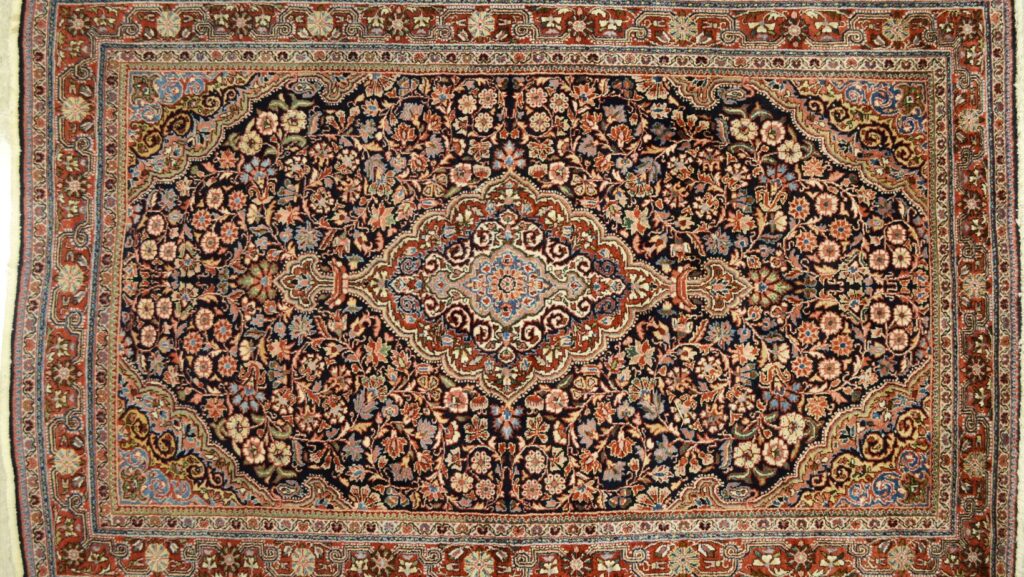
Persian rugs, known for their intricate designs and superior craftsmanship, have been woven in Iran for thousands of years. Each rug tells a story, reflecting the rich cultural heritage and skilled craftsmanship of its makers.
In this guide, we will explore the various types of Persian rugs, helping you to understand their distinctive features and appreciate their timeless beauty.
History and Origin of Persian Rugs
The history of Persian rugs dates back over 2,500 years, making them one of the oldest forms of art still in existence today. The earliest known Persian rug, the Pazyryk Carpet, was discovered in a Siberian tomb and dates back to the 5th century BCE. This ancient artefact showcases the remarkable skill and artistry that has been passed down through generations of Persian weavers.
Persian rugs hold a special place in Iranian culture, seen as symbols of national identity and pride. Historically, they were used in royal courts and palaces, signifying wealth and status. Each region of Iran developed its own unique styles and techniques, resulting in a diverse array of designs that reflect the local culture, climate and history.
The Safavid Dynasty (1501-1736) was a golden age for Persian rug weaving. During this period, the art form flourished, with workshops established across the country. The finest materials, such as silk and high-quality wool were used, and intricate designs featuring floral motifs, medallions and hunting scenes became prominent. Persian rugs from this era are highly sought after by collectors and museums worldwide.
Today, Persian rugs continue to be cherished as family heirlooms, often passed down from one generation to the next. The traditional techniques and patterns remain largely unchanged, preserving the rich heritage and continuing the legacy of Persian rug weaving.
The Art of Persian Rug Weaving
Crafting a Persian rug is a meticulous process that requires great skill and patience. Wool is the most commonly used material, valued for its durability and softness. Some Persian rugs may also incorporate the use of silk which creates a luxurious sheen and allows for finer, more intricate designs. Cotton is often used for the foundation of the rug, providing strength and stability.
The weaving process is traditionally done by hand on a loom where each knot is tied individually. The number of knots per square inch (KPSI) is a key indicator of the rug’s quality; the higher the knot density, the finer and more detailed the design can be.
Designs in Persian rugs are rich in symbolism and artistry. Common motifs include floral patterns and geometric shapes. Medallion designs, featuring a central motif surrounded by intricate patterns, are also prevalent. Each design element is carefully planned and executed, often taking months or even years to complete a single rug.
Natural dyes, derived from plants & minerals, are traditionally used to colour Persian rugs. These dyes produce rich, vibrant hues that can withstand the test of time.
Types of Persian Rugs
Persian rugs come in a variety of styles, each with its own unique characteristics and origins.
Tabriz Rugs
Tabriz rugs originate from the city of Tabriz in north-western Iran, one of the oldest weaving centres in the country.

Known for their exceptional craftsmanship and high knot density, Tabriz rugs often feature medallions, floral patterns and hunting scenes. The colours are typically rich and vibrant, with deep reds, blues and earth tones. Tabriz rugs are highly prized for their detailed designs and fine quality.
Keshan Rugs
Keshan rugs hail from the city of Keshan in central Iran. These rugs are known for their elegance and classic beauty, often featuring a central medallion surrounded by floral motifs. The colours are usually deep and warm, with a prominent use of reds, blues and ivory. Keshan rugs are woven with high-quality wool and sometimes silk, which gives them a luxurious texture and sheen.
Isfahan Rugs
Isfahan rugs are woven in the city of Isfahan, a major cultural and artistic hub in Iran. These rugs are renowned for their exquisite craftsmanship and artistic designs. Isfahan rugs typically feature intricate patterns with floral and arabesque motifs, often set against a cream or ivory background. They are often woven with fine wool or silk, resulting in a smooth and lustrous finish. The high knot density allows for very detailed and refined designs, making Isfahan rugs highly sought after by collectors.
Heriz Rugs
Heriz rugs are crafted in the Heriz region of north-western Iran. These rugs are known for their bold, geometric patterns and soft, durable pile. The colours are vibrant, with reds, blues and oranges being common. Heriz rugs are typically woven with thicker wool, making them sturdy and long-lasting, suitable for high-traffic areas in the home.
Caring for Persian Rugs
Regular cleaning is important to keep your Persian rug looking its best. Vacuum your rug regularly to remove dirt and dust, but be gentle to avoid damaging the fibres. Use a vacuum cleaner without a beater bar to prevent pulling and tearing.
For deeper cleaning, it is best to consult a professional rug cleaner who specialises in Persian rugs. If you need to clean a spill or stain, blot the area immediately with a clean, dry cloth. Use a mild detergent mixed with water for spot cleaning.
If your rug includes a care label we’d always recommend referring to this first for best practice on how to maintain your rug.

Persian rugs are not just decorative items for your home, but timeless pieces of art that embody a rich cultural heritage and unparalleled craftsmanship. By understanding the different types, recognising authenticity, and knowing how to care for these rugs, you can fully appreciate their beauty and value.












